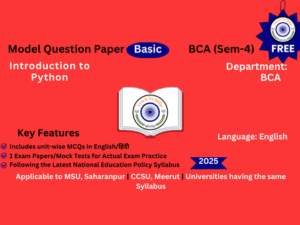कोशिका विज्ञान, आनुवंशिकी और संक्रामक रोग (सेमेस्टर -1)
- Description
- Curriculum
- Reviews

Teach To India प्रकाशन
कोशिका विज्ञान, आनुवंशिकी और संक्रामक रोग
-
यह मॉडल पेपर यह सुनिश्चित करता है कि सभी संभावित प्रश्न जो परीक्षा में आ सकते हैं, वे यूनिट में पूरी तरह से शामिल हैं, चाहे वे सीधे हों या अप्रत्यक्ष रूप से।
-
इसे अनुभवी प्रोफेसरों द्वारा बहुत सावधानी से तैयार किया गया है, जिन्हें परीक्षा मॉडल पेपर बनाने का व्यापक अनुभव है।
-
इस पेपर में विश्वविद्यालय द्वारा निर्धारित पाठ्यक्रम के आधार पर सभी मुख्य प्रश्न शामिल हैं।
-
400 से अधिक प्रश्न और उत्तरों के साथ, यह मॉडल पेपर विषय का पूरा पाठ्यक्रम कवर करता है।
-
प्रत्येक यूनिट में दीर्घ उत्तरीय ,लघु उत्तरीय और अति लघु उत्तरीय वाले प्रश्न शामिल हैं ताकि छात्रों को गहन समझ प्राप्त हो सके।
-
हमारे प्रश्न इस तरह तैयार किए गए हैं कि प्रत्येक यूनिट को कम से कम और अच्छी तरह चुने हुए प्रश्नों से कवर किया जा सके।
-
अनिवार्य आंतरिक परीक्षा के लिए हम 200 एक पंक्ति के प्रश्न-उत्तर प्रदान कर रहे हैं, जो प्रत्येक यूनिट को समान रूप से कवर करते हैं।
-
इस मॉडल पेपर में मॉक प्रश्नपत्र / पिछले साल के प्रश्नपत्र भी हल के साथ दिए गए हैं, जिससे छात्रों को परीक्षा के प्रश्नों की गहराई और विस्तार को समझने में मदद मिलती है।
|
Programme /Class: Certificate |
Year: First |
Semester: First |
||
|
Subject: ZOOLOGY |
||||
|
Course Title: : Cytology, Genetics and Infectious Diseases |
||||
|
Course outcomes: The student at the completion of the course will be able to: ● Understand the structure and function of all the cell organelles. ● Know about the chromatin structure and its location. ● To be familiar with the basic principle of life, how a cell divides leading to the growth of an organism and also reproduces to form new organisms. ● How one cell communicates with its neighbouring cells? ● Understand the basic principles of genetics and how genes (earlier called factors) are inherited from one generation to another. ● Understand the Mendel’s laws and the deviations from conventional patterns of inheritance. ● Comprehend how environment plays an important role by interacting with genetic factors. ● How to detect chromosomal aberrations in humans and study the pattern of inheritance by pedigree analysis in families.
|
||||
|
Credits: 4 |
Core: Compulsory |
|||
|
Max. Marks: 25+75 |
Min. Passing Marks: 8+25 |
|||
|
Unit |
Topics |
|||
|
I |
Structure and Function of Cell Organelles I Plasma membrane: chemical structure—lipids and proteins Cell-cell interaction: cell adhesion molecules, cellular junctions Endomembrane system: protein targeting and sorting, endocytosis, exocytosis
|
|||
|
II |
Structure and Function of Cell Organelles II Cytoskeleton: microtubules, microfilaments, intermediate filaments Mitochondria: Structure, oxidative phosphorylation, electron transport system Peroxisome and ribosome: structure and function
|
|||
|
III |
Nucleus and Chromatin Structure Structure and function of nucleus in eukaryotes Chemical structure and base composition of DNA and RNA DNA supercoiling, chromatin organization, structure of chromosomes Types of DNA and RNA
|
|||
|
IV |
Cell cycle, Cell Division and Cell Signaling Cell division: mitosis and meiosis Introduction to Cell cycle and its regulation, apoptosis Signal transduction: intracellular signaling and cell surface receptors, via G-protein linked receptors Cell-cell interaction:cell adhesion molecules, cellular junctions |
|||
|
V |
Mendelism and Sex Determination Basic principles of heredity: Mendel’s laws, monohybrid and dihybrid crosses Complete and Incomplete Dominance Clinical expressions:Penetrance and expressivity Genic Sex-Determining Systems, Environmental Sex Determination, Sex Determination in Drosophila Sex-linked characteristics and Dosage compensation
|
|||
|
VI |
Extensions of Mendelism, Genes and Environment Extensions of Mendelism: Multiple Alleles, Gene Interaction The Interaction Between Sex and Heredity: Sex-Influenced and SexLimited Characteristics Cytoplasmic Inheritance, Genetic Maternal Effects Genomic Imprinting, Anticipation Interaction Between Genes and Environment: Environmental Effects on Gene Expression, Inheritance of Continuous Characteristics
|
|||
|
VII |
Human Chromosomes and Patterns of Inheritance Human karyotype Chromosomal anomalies: Structural and numerical aberrations with examples Pedigree analysis Patterns of inheritance: autosomal dominant, autosomal recessive, X-linked recessive, X-linked dominant
|
|||
|
VIII |
Infectious Diseases Introduction to pathogenic organisms: viruses, bacteria, fungi, protozoa, and worms. Structure, life cycle, pathogenicity, including diseases, causes, symptoms and control of common parasites: Trypanosoma, Giardia and Wuchereria
|
|||
-
1यूनिट-1:कोशिका विज्ञान, आनुवंशिकी और संक्रामक रोग
-
2यूनिट-2:कोशिका विज्ञान, आनुवंशिकी और संक्रामक रोग
-
3यूनिट-3:कोशिका विज्ञान, आनुवंशिकी और संक्रामक रोग
-
4यूनिट-4:कोशिका विज्ञान, आनुवंशिकी और संक्रामक रोग
-
5यूनिट-5:कोशिका विज्ञान, आनुवंशिकी और संक्रामक रोग
-
6यूनिट-6:कोशिका विज्ञान, आनुवंशिकी और संक्रामक रोग
-
7यूनिट-7:कोशिका विज्ञान, आनुवंशिकी और संक्रामक रोग
-
8यूनिट-8:कोशिका विज्ञान, आनुवंशिकी और संक्रामक रोग







